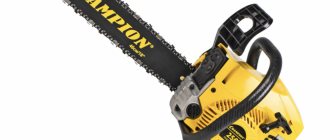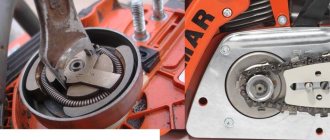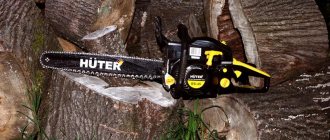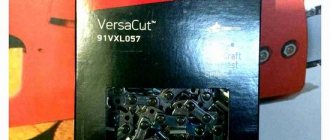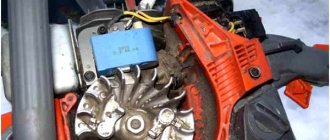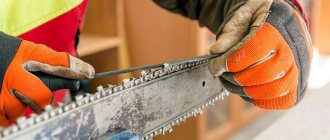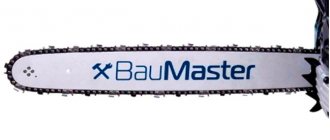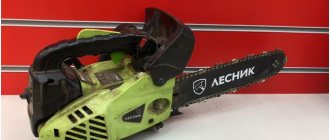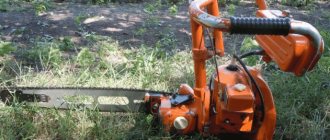Household, semi-professional and professional hand-held chainsaw equipment, regardless of cost and performance characteristics, has an identical design. The cutting set, which includes a chainsaw bar and saw chain, belongs to the category of replacement equipment.
The decision on which tire to put on a chainsaw is made by the owner, taking into account many factors. First of all, this is the compatibility of the seat and the channels for supplying lubricant to the working area, engine power, and the specifics of the work to be done.
Specific assistance in choosing a tire independently can be provided by recommendations from experienced specialists or information from the instructions for use.
In particular, a long saw set is preferable for felling and sawing large-diameter trees, while a short saw set is preferable for crowning trees and preparing for the installation of construction timber.
General design
In the standard solution, the longitudinal chainsaw bar is a part made of high-quality steel with an elongated oval configuration.
At one end there are holes for threaded fasteners, at the other end of the long tires a driven sprocket is installed. This arrangement of the tire contributes to the smooth running of the chain and reduces the load on the engine.
There is a groove along the perimeter of the bar into which the saw chain shanks are inserted. Through special drillings for cooling and lubrication of the headset, chain oil is supplied to the working area in measured quantities.
Functions and structure of a chainsaw
In order to understand the peculiarities of the procedure under consideration, you should carefully examine the devices of the chainsaw. Among the features, the following points can be noted:
- The main part is represented by the engine. A single cylinder design is almost always installed because this is completely sufficient for cutting.
- The piston system is two-stroke, and the cooling is air. During operation, a relatively small amount of thermal energy is released, so blowing is sufficient to remove heat.
- As in almost all other designs, this one requires oil, which ensures smooth movement of the moving element. Oil is added directly to the fuel. Depending on the design features, oil and fuel are mixed in a spectrum of 1:20 or 1:50.
- An air filter can also be called a fundamental structural element. Fuel is mixed with air to obtain a certain consistency, which is supplied to the combustion chamber. If you do not constantly clean the filter element, in other words, there is a possibility that debris will get into the cylinder block. This will be a prerequisite for rapid wear or even jamming of the device.
- The starter is a special design that is driven by a rope with a handle. If the rope is pulled very hard, the flywheel is set in motion.
- The main working mechanism is represented by a tire with a fastener. It is designed to guide the chain and secure it.
- A traditional chain consists of 3 teeth: driving, cutting, connecting. The cutting edge is secured using rivets.
A fairly common situation is the case when you have to pull the handle for a long time. It is due to the fact that the carburetor incorrectly mixes fuel with air. It is almost always enough to configure the device in accordance with the operating features. A chainsaw will not last long if proper maintenance is not provided.
Dimensional characteristics
The guide groove of the chainsaw bar of a household category has a width of 1.1 or 1.3 mm. The same figure for professional models is 1.5-1.6 mm. A discrepancy between the thickness of the chain shank and the width of the groove can initiate overheating of the headset and its premature failure. In another embodiment, the chain may come out of the groove or break.
Similar consequences can occur if the pitch of the chain and the crown of the drive mechanism do not match. In many chainsaw models, replacing the drive sprocket involves time-consuming dismantling of the clutch assembly. In some cases, service and repair level equipment is required.
The most popular sprocket and saw chain pitch for saws up to 3 hp. - 0.325 inches. Professional chainsaw equipment typically uses 3/8-inch pitches.
The driven tire sprocket is not centrally lubricated. This disadvantage is compensated by the high quality of the bearing, which must be lubricated every 8-10 hours of operation. A complete replacement of the driven tire sprocket is possible only in an equipped workshop.
Chainsaw tire repair
Among the few problems that arise during the operation of the guide, the most pressing is related to wear or deformation of the driven sprocket. This is a relatively simple problem that can be repaired at home. It is expressed in sprocket jamming or large play in the chain shanks with teeth. For repairs you will need a welding machine, an angle grinder and a suitable repair kit.
- First of all, you need to remove the damaged part. To do this, grind off the rivets with an abrasive wheel and carefully knock them out with a hammer.
- We remove the damaged element and thoroughly clean the groove (preferably with a rag soaked in kerosene).
- Before placing the new sprocket in the tire, a layer of grease (lithol) must be applied to the bearing rollers.
- As a fixing element, you can use previously knocked out rivets, placing them on a couple of drops of welding on both sides. The protruding solder is removed with a grinding wheel.
If purchasing a replacement sprocket is equivalent to buying a new tire, you can try to recondition the old one. Relevant when jammed, when the rollers are scattered and worn out, but the part itself can still work. An ordinary drill with a diameter of about 2.5 mm (to coincide with the standard rollers) can act as a source of replacement elements.
We simply clamp the drill in a vice and cut jewelry washers (you can use an abrasive one, but be careful with a diamond one). To prevent small parts from scattering, it is better to install a magnet nearby that will attract the elements when trimming. To obtain a complete set of rollers and fill the circle, you will need about 2 drills of standard length. Having cut the required number of round pieces, we place them in an asterisk and proceed to points 3, 4 of the previous instructions.
The described restoration method will extend the service life of the guide, but soon a problem will arise with the wear of the sprocket, and it will have to be replaced (or the entire set). A more complete demonstration of the restoration process is presented in the following video, which clearly shows the entire DIY chainsaw bar repair. The video, with useful comments from the author, conveys all the main aspects of the work.
Try to regularly care for your tire and its service life will increase significantly. Clean the groove from dirt, lubricate the driven sprocket bearing and remove burrs with a file. By devoting 5 minutes to maintenance per 10 hours of operation, you will increase operational efficiency and save yourself from unnecessary costs.
article from the Rating section
- 0
Gasoline tools Consumables
Save this page on your social media. network and return to it at any time.
ADD A COMMENT
Criteria for choosing a tire based on quality characteristics
Tires standardized in seat sizes are presented in a small assortment. As a rule, each manufacturer uses its own standards, which excludes the possibility of operating a chainsaw with sawing equipment from other brands.
- The selling price of guide bars is determined by the size, quality of the material and brand recognition. The most expensive, high-quality and durable products from leading manufacturers.
- The high cost of branded tires is fully compensated by their high wear resistance and long service life.
- In the middle price range there is an assortment of budget-level tires that are equipped with gas and electric saws of the household class. With proper operation and qualified maintenance, Standard category tires exceed the service life specified by the manufacturer.
Less popular are cheap, short-lived tires made in China, which are installed on chainsaws in the minimum price range. A significant part of such products is sold under the trademarks of well-known brands.
Circuit voltage
Stretching can be done using two methods: quick and forward. If stretch is used, then installing the chain on the chainsaw is carried out as follows:
- The nuts are unscrewed.
- The tire is held and lifted from the edge.
- There is a special bolt that is used to tension the chain.
- The tire is raised to eliminate the possibility of sagging.
This type of work is quite easy to do and requires a small set of tools.
Tensioning the chain clockwise is carried out when there is not a lot of free time. The chain screw is fixed firmly to eliminate the possibility of rattling during operation.
How to eliminate the possible risks of purchasing counterfeit tires?
The information field contains signs by which it is easy to distinguish an original branded chainsaw from the most reliable fake. As for tires, their advantages and disadvantages manifest themselves directly in operation.
In the domestic market of household appliances, about 15% of the total sales of chainsaw components are third-rate counterfeits of unknown origin, producing at best half of the standard resource.
Operating a chainsaw complete with a fake bar and chain is economically unprofitable and unsafe. A significant number of traumatic situations are created when using counterfeit tires and chains.
You can buy a high-quality and durable branded tire of the desired model, without significant risks, at a branded outlet or representative office of a licensed dealer company. If this is not possible, you should use the services of a reputable online store that has earned the trust of customers.
Design features of household and professional tires
The design of modern saw sets is constantly being improved. As a result of partial modernization, the so-called narrow tire was developed.
Structurally, such models are distinguished by the shape of the tip, which prevents kickback when the headset enters the cut. Domestic-grade chainsaw equipment is mostly equipped with narrow tires. A wide toe is a characteristic feature of the tire intended for sawing work of increased complexity, as well as professional category chainsaws.
Selecting the bus length based on drive power
The length of the new guide bar is determined by the power and torque coefficient of the power unit.
- Models of chainsaws in the small and medium power range are equipped with tires with a length of 30 to 40 cm.
- Longer saw sets create excessive loads on the engine and kinematics of the tool, which negatively affect its traction characteristics and service life.
- Please see the enclosed instruction manual for the recommended length of the guide bar. This means that installing a shorter headset is not excluded, but there are a number of restrictions on the operation of the instrument with an extended length bus.
Professional-level chainsaw equipment is equipped with power units whose power allows you to take advantage of tires up to 75 cm long. Often the tire size in centimeters and inches is marked on its side plane.
How to properly install a chain on a chainsaw
A chainsaw can be used to perform quite a huge number of jobs. The main cutting element of such a tool is represented by a chain with different blades. Modern embodiments are characterized by the fact that they can be serviced without the help of others. With long-term cutting or failure to follow the main tips, the cutting edge quickly wears out. That’s why you have to remove and sharpen the chain, and then install it. A similar procedure is characterized by a fairly huge number of features, which we will discuss in more detail later.
READ Chainsaw Carburetor Idle Speed Adjustment
Recommendations for extending service life
The approximate service life of a branded tire is equal to the total service life of 3 high-quality saw chains; the drive sprocket varies depending on its condition. Experts recommend using a set of several circuits.
This method allows you to reduce the loss of working time, which is spent on periodic sharpening of chains, as well as optimize the wear of the saw mechanism as a whole. Accelerated tire wear is a consequence of unqualified maintenance of the chainsaw and its illiterate operation.
The main factors for early tire failure:
- excessive chain tension or discrepancy between its pitch and the characteristics of the drive sprocket crown, which initiates the rapid development of the groove and shanks;
- applying significant force when sawing hard or frozen wood;
- the tire heats up and wears out intensively due to lack of lubricant supply, due to a malfunction or incorrect adjustment of the standard oil pump;
- saving money on the use of low-quality chain oil or oil surrogates such as waste.
Forced consumption of the saw set resource occurs when soil or sand gets into it, or when a new chain operates on a worn drive sprocket.
The chain is stretched
If the chain is used incorrectly or for a long time, it can become very stretched. This is due to the fact that metal can become deformed over time. Very severe wear becomes a prerequisite for which it is necessary to obtain a new version, but it is possible to use the old one for a short period. You can avoid rapid stretching only if you follow the operating instructions. To carry out the work you need:
- Hammer.
- Vise.
- Welding machine.
- Beards.
- Pliers.
It is not difficult to put on the stretched version, but with restoration there are quite a lot of problems, because the metal is characterized by increased strength. In this case, the main elements are fastened with rivets. The work is carried out as follows:
- The product is fastened in cleats.
- If the work is carried out using a grinder, in other words, there is a possibility that the surface will be damaged, because this tool is difficult to keep under control.
- After grinding, the rivets are knocked out. There is no need to throw it away because of its ability to be re-introduced.
- Chain manufacturers do not produce spare parts that are required for maintenance.
- You can make a rivet yourself, but the work is quite complicated.
- The product is divided into two parts. It is worth considering that the number of guides and the distance between them must remain constant.
When solving a problem with a large length, one should not forget that a very small chain cannot be tensioned. In addition, it is not recommended to apply oil to the chain of an electric saw.
Installing the bar and chain
The tire is dismantled to clean the oil line, check its technical condition, or replace it. The operation sequence is described in the operating instructions. Upon completion of installation, ensure that there is no play and that the threaded fasteners are tight.
If you have certain skills, it only takes a few minutes to dismantle and install a new or sharpened chain. The technology requires the inclusion of an unauthorized start blocker and, in some cases, an emergency stop mechanism.
- Depending on the design of the tensioner, the chain is loosened to the desired extent by rotating the adjusting screw or setting disk until the shanks freely exit the groove of the guide bar.
- After checking the direction of rotation, the shanks of the new chain are inserted into the guide groove and onto the crown of the drive sprocket. Tensioning is done in the reverse order.
- To check the degree of tension, simply pull the chain in the middle of the bar. The extension of the link shank in this place should not exceed 2/3 of its height. A properly tensioned chain should move along the bar with little effort.
After installing and adjusting the saw set, it is advisable to start the engine and keep the saw at medium speed for several minutes. During this time, you can check the operation of the lubrication system.
After turning off the power unit, it is necessary to turn on the start lock and check the headset for local overheating of the tire and changes in the degree of chain tension.
How to properly put a chain on a chainsaw?
In most models of chainsaws, the chain can simply be put on the bar by unscrewing the head screw, then the links must be placed on the drive sprocket. Before work, you should inspect the general condition of all cutting surfaces and the guide groove and installation wheel. Often, dirt and small chips accumulate in it, which will then lead to scheduled repairs and deterioration of gliding. Step by step working method:
- Loosen the screws securing the sprocket protective cover; it is usually tightened with a wing nut.
- Turn the tension sprocket to the right until it stops.
- Place the links on the headset, starting from the top. Finish the drink so that they fall into the proper grooves.
- Secure the chain sprocket mount back and tighten the nut. The guides must fit into a special groove.
- Release the chain brake and pull the chain along the mowing line to check the tension. Tighten the tensioner lever as necessary. Sketch 4 – Installing chain on chainsaw
The installation wheel should turn freely after installing the chainsaw chain. At the end of the work, be sure to lubricate all moving elements of the tool to avoid rapid wear.
Lead star problems
From time to time, chain slack occurs due to problems with the drive sprocket. A more common situation is when it is poorly secured. Step-by-step method to tighten the sprocket:
- Remove the motor protective cover.
- Remove the air filter and unscrew the spark plug, placing in its place a special stopper to fix the piston in a stationary position.
- Using an angle grinder wrench, rotate the clutch disc clockwise to its highest position. Check the tightness of the sprocket and adjust its position. Sketch 3 – Chainsaw Lead Star
After clamping, assemble the chainsaw back, be sure to put on the protective cover. When assembling, you should check that the chain fits tightly onto the bar.
Tire installation on Stihl and Husqvarna
Models of chainsaws from the manufacturer Stihl may differ during the assembly process. Step by step control:
- Open the wing nut and remove the protective cover of the chain sprocket. Turn it on the tire all the way to the right.
- Place the chain on the bar, starting from the top, with the cutting tooth on the top side pointing straight ahead.
- Place the assembled tire on the chainsaw and pull the structure onto the sprocket. Slide the guide onto the shoulder bolt. Close the lid by inserting the pins into the holes provided by the manufacturer.
- Turn the wing nut until the sprocket cover touches the motor housing.
- Turn the clamp bolt forward until the drive links fit into the grooves in the bar. Tighten the wing nut completely.
At the end of the work, check the tension; if the headset does not move well, adjust the tension with the nut. The chain brake must be engaged before starting.
The method for installing a bar with a chain for Husqvarna saws is actually similar. The main difference is that in most models, the tension and adjustment of the location of the headset to the body is controlled not by one, but by 2 wing nuts. There is rarely a separate adjustment lever on the protective housing of the outer sprocket, so the tension should be adjusted only with bolts.
The chain has stretched
Any multifunctional chain configurations lead to decreased tool productivity and injuries during operation.
READ Chainsaw Oleo Mac Won't Start
You should check frequently to ensure that there is no metal deformation or stretching of more than 1 cm.
If such a problem does appear, you need to purchase a new chain or correct the old one.
Separate the chain links on the machine or fix it in a vice, grind off the rivets with a grinder and knock them out with a bit (it is not recommended to use a grinder).
Remove 1-2 links depending on the degree of chain stretch. Then put all the elements in place, insert the rivet and knock it off with a hammer, use a special rivet tool. For reliability, it is recommended to use a welding machine. At the end of the work, grind off excess and burrs with a narrow needle file.
